Visual kei
Visual kei (Japanese: ヴィジュアル系, Hepburn: Vijuaru Kei, lit. "Visual Style" or "Visual System") is a movement among Japanese musicians,[1][2][3] that is characterized by the use of varying levels of make-up, elaborate hair styles and flamboyant costumes, often, but not always, coupled with androgynous aesthetics,[4][5][6] similar to Western glam rock.[7]
| Visual kei | |
|---|---|
| Stylistic origins | |
| Cultural origins | Early 1980s, Japan |
| Typical instruments | Vocals • electric guitar • bass guitar • acoustic guitar • drums • keyboards |
| Subgenres | |
| Eroguro kei • Oshare kei | |
| Regional scenes | |
| Nagoya | |
| Other topics | |
| Japanese popular culture • Japanese street fashion | |
Some Western sources consider visual kei a music genre,[8][9] with its sound usually related to glam rock, punk rock and heavy metal.[5][10][11][12] However, visual kei acts play various genres,[13][1][14][15][16] including those considered by some as unrelated to rock such as electronic, pop, etc.[2][5] Other sources, including members of the movement themselves, state that it is not a music genre and that the freedom of expression, fashion and participation in the related subculture is what exemplifies the use of the term.[17][18][19][20][21]
Etymology
The term "visual kei" was derived from one of X Japan's slogans, "Psychedelic Violence Crime of Visual Shock", seen on the cover of their second studio album Blue Blood (1989).[22][23][24] This derivation is credited as being coined by Seiichi Hoshiko, the founding editor of Shoxx magazine, which was founded in 1990 as the first publication devoted to the subject. However, he explained in a 2018 interview with JRock News that visual kei was technically coined, or at least inspired by, X Japan's lead guitarist hide. Hoshiko also said that at the time they were called 'Okeshou Kei' (お化粧系, Okeshō Kei, "Makeup Style") "But it simply felt... too cheap... Even though X Japan was a big band and people used the term 'Okeshou kei' to describe them, the term was still lacking substance, I didn't like the term at all! Because of this, I tried to remind all the writers to not use this term as 'They are not okeshou kei, they are visual-shock kei'. From there, it went from 'Visual-shock kei' to 'Visual-kei' to 'V-kei'. After we spread the word, fans naturally abbreviated it to 'V-kei'. The Japanese love to abbreviate everything as a matter of fact." Hoshiko considers visual kei a distinctive Japanese music genre and defined it "as the music itself along with all the visual aspects of it."[25][26]
History
1980–1992: Origins and success
Visual kei emerged in the 1980s underground scene,[6] pioneered by bands such as X Japan, Dead End, Buck-Tick, D'erlanger, and Color.[27][23][28][29] The movement designated a new form of Japanese rock music influenced by Western hard rock and glam rock/metal acts like David Bowie, Kiss, Twisted Sister, Hanoi Rocks, Mötley Crüe, as well as punk-gothic rock and was established in the late 1980s and early 1990s.[22] In The George Mason Review, Megan Pfeifle described the movement as being roughly divided into two generations, with the first in three transitional eras,[30] of which the first lasted just over a decade.[31]
In the late 1980s and until the mid-1990s, visual kei received increasing popularity throughout Japan, when album sales from such bands started to reach record numbers.[6][32] The first band with recordings that achieved notable success was Dead End, whose independent album Dead Line (1986) sold over 20,000 copies,[33] and whose major label debut album Ghost of Romance (1987) released by Victor Entertainment reached No. 14 on the Oricon Albums Chart.[34] That same year, Buck-Tick released their major debut Sexual XXXXX! through the same record label.[35] Dead End even had two albums released by American label Metal Blade Records. However, Dead End and D'erlanger disbanded in 1990, while in 1988 to 1989 Buck-Tick and X Japan started to gain mainstream success that continues to present-day. Buck Tick's single "Just One More Kiss" entered No. 6 on the Oricon Singles Chart, while their studio albums Seventh Heaven (1988) and Taboo (1989) charted at No. 3 and 1 respectively and were the first Japanese rock band to hold a concert at the Tokyo Dome.[35] They continue to have success, with nearly all of their subsequent albums reaching the top ten on the charts. X Japan's first album, the independently released Vanishing Vision, reached No. 19 in 1988, making them the first indie band to appear on the main Oricon Albums Chart.[36][37] Their second and major debut album Blue Blood (1989) reached number 6 and has since sold 712,000 copies.[38] Their third and best-selling album Jealousy was released in 1991, topped the charts and sold over 1 million copies.[38] They went on to release two more number one studio albums, Art of Life (1993) and Dahlia (1996). In 1992, X Japan tried to launch an attempt to enter the American market, even signing with Atlantic Records for a US album, but this ultimately did not happen.[39]
Two record labels formed in 1986, Extasy Records (Tokyo) and Free-Will (Osaka), were instrumental in promoting the visual kei scene.[23] Extasy was created by X Japan drummer and leader Yoshiki and signed bands, not limited to visual kei acts, that would go on to make marks on the Japanese music scene, including Zi:Kill,[40] Tokyo Yankees and Ladies Room. Luna Sea and Glay, who both went on to sell millions of records, with Glay being one of Japan's best-selling musical acts, had their first albums released by Extasy in 1991 and 1994.[40] Free-Will was founded by Color vocalist and leader Dynamite Tommy, and while at the time not as popular as Extasy, it had many moderately successful acts, such as By-Sexual and Kamaitachi.[23] Currently Free-Will is still going strong and has been a major contributor in spreading modern visual kei inside and outside Japan, whereas Extasy followed its owner and became based out of the US, signing and producing American acts and has since faded away.
1993–2000: Expansion and decline
.jpg)
Pfeifle described the second transition era as beginning in 1993 with bands such as L'Arc-en-Ciel, Glay (although formed in 1988, their first album was released in 1994) and Malice Mizer. They gained mainstream awareness, although they were not as commercially successful, except for L'Arc-en-Ciel and Glay whose later huge success was accompanied by a drastic change in their appearance and are often not associated with visual kei.[31] Around 1995, visual kei bands experienced a booming success in the general population, which lasted for four years.[31] According to Pfeifle, the third transition era began by bands such as La'cryma Christi, Penicillin and Rouage achieving moderate success.[31] At the time, "the big four of visual kei" were Malice Mizer, La'cryma Christi, Shazna and Fanatic Crisis.[41][42][43] In 1998, Pierrot released their major debut single,[44] and Dir en grey's three major label singles were released with the help of Yoshiki the following year.[45] They were called "the big two" in the scene at that time.[46]
Around the early 1990s, a visual kei scene that placed more emphasize on music rather than fashion arouse in the city of Nagoya, and as such was later dubbed Nagoya kei.[47] Silver-Rose (formed in 1989) and Kuroyume (formed in 1991) were described as the "Nagoya big two" in the underground scene,[47] and with Laputa (formed in 1993[48]),[49] are credited with "creating the early Nagoya kei style."[50] During the 1990s, several other conceptual subgenres like Eroguro kei (notably represented by Cali Gari), Angura kei (underground style, wearing traditional kimonos or Japanese uniforms) and Ouji kei or Kodona kei (prince style or boy style, notably Plastic Tree) emerged.[31]
By the late 1990s, the mainstream popularity of visual kei was declining;[11] Luna Sea went on a year-long hiatus in 1997 before disbanding in 2000, X Japan disbanded at the end of 1997 and one year later their lead guitarist hide died. In 1999, Malice Mizer's drummer Kami died after the departure of singer Gackt,[51] who with a toned down appearance became one of the most popular and successful visual kei solo singers,[52] and L'Arc-en-Ciel publicly distanced themselves from the movement (although, in 2012 they were partly promoted internationally as a visual kei band[53]).[22] In 1998, Billboard's Steve McClure commented that "To a certain extent, hide's death means the end of an era, X were the first generation of visual kei bands, but the novelty has worn off. For the next generation of bands, it's like: That's it. The torch has been passed to us".[4] As other bands could not meet financial expectations, most major companies backed out of the movement,[22] and it became an underground style often associated with the rebellious generation, non-conforming to proper society.[31]
2001–2009: Neo-Visual Kei
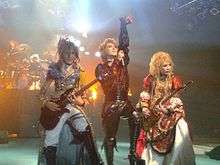
A second generation emerged in small visual kei-specific live houses managed by record companies like PS Company (Free-Will) and Maverick DC Group.[22] The difference between the first and second generation is that the second; has no straightforward music style, ranging from metal to pop, but still seemingly focused on heavy rock genres; the fashion and gender ambiguities are of central importance. Although economically not very significant in the Japanese music market, it became the first Japanese music to succeed on an international scale.[13]
Notable newer visual kei bands include Dir en grey, The Gazette, Alice Nine, D'espairsRay and Girugamesh, as well as solo performer Miyavi,[54][55] who have all performed overseas.[23] Veterans of the scene also established new acts, such as Malice Mizer's Mana with his band Moi dix Mois and three members of Pierrot forming Angelo.[23] In 2007, visual kei was revitalized as Luna Sea performed a one-off performance and X Japan officially reunited with a new single and a world tour. With these developments, visual kei bands enjoyed a boost in public awareness, with acts formed around 2004 having been described by some media as "Neo-Visual Kei" (ネオ・ヴィジュアル系).[31][32] From this generation the subgenre "oshare kei" (オサレ系) emerged, where the musicians produce upbeat pop rock and wear bright colorful attire.[31] Pioneers of this style include Baroque, Kra, Charlotte and An Cafe.[56]
Although the first international concert by a visual kei act was held in Taiwan by Luna Sea in 1999, it was not until 2002 that many visual kei bands started to perform worldwide (United States, in Europe from 2004), with the initial interest coming from Japanese-themed conventions like A-Kon.[30] In the first five years Dir en grey was especially well received.[57] In 2007, the Jrock Revolution event was held in Los Angeles and featured visual kei bands.[58] Although some bands like The Gazette have played at Tokyo Dome (not at full capacity), the majority of acts play in much smaller venues like Shibuya O-East.[59] In 2009 the V-Rock Festival at Makuhari Messe was reported as the "world's largest Visual Kei music festival" gathering over 50 "visual artists," although this included some Western acts like Marilyn Manson.[60] A second V-Rock Festival was held in 2011 at Saitama Super Arena.[61][62]
2009–present: Reunions
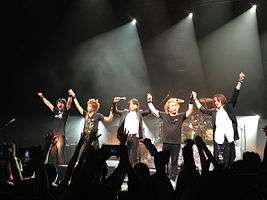
Dead End officially reunited in 2009 and La'cryma Christi (which disbanded in 2007) reunited for an anniversary tour in 2010.[63][64] Kiyoharu announced the reformations of both Kuroyume and Sads,[65] and Luna Sea reunited and began a world tour.[66]
As an epilogue to their 25th anniversary, Luna Sea hosted a rock festival titled Lunatic Fest on 27 and 28 June 2015, with an estimated 60,000 fans attending.[67] Held at Makuhari Messe, there were three stages and 12 artists,[68] most visual kei acts including X Japan, Dead End, Dir en grey, Siam Shade and Tokyo Yankees the first night,[69][70][71] and Aion, Buck-Tick, D'erlanger, Glay and Mucc the second night.[72]
A large three-day visual kei rock festival titled Visual Japan Summit was held at Makuhari Messe between October 14–16, 2016.[73][74]
Luna Sea hosted another two-day Lunatic Fest at Makuhari Messe on June 23 and 24, 2018.[75]
In the 2010s, some of the internationally most popular visual kei acts (based on sales figures from music store CDJapan) include The Gazette, Kamijo, Nocturnal Bloodlust, Versailles, Jupiter, Mejibray, lynch., Dimlim, Matenrou Opera, Miyavi, D, Diaura, Dadaroma, Initial’L, A9, Buck-Tick, Yoshiki, Hyde, Luna Sea, Mucc, Hizaki and Gackt.[76][77][78][79]
Criticism
There has been criticism directed at newer visual kei bands for having lost the spirit of their forefathers by copying each other in design and sound, and becoming all the same.[31] As far back as 1998, Neil Strauss reported that to visual kei bands "after X" makeup and outrageous looks became "more important than music."[4] Several musicians have expressed their discontent; in 2008, Kirito (Pierrot, Angelo) said "now it's more like people are dressing up a certain way because they want to be visual kei or look visual kei. They are doing it to look like others instead of doing it to look different. This is obviously very different from when we started out more than ten years ago,"[18] while Sugizo (Luna Sea) stated in 2010 that "they cannot make good sounds and music is more like a hobby for them. I cannot feel their soul in the music."[80]
Although almost from the newer generation himself, Dir en grey bassist Toshiya said in 2010 "to be honest, when we first started and we were wearing a lot of makeup on stage and stuff, there were a lot of bands doing that at the time in Japan and people thought it was cool. But not anymore, ha ha." and added "the music was so unique, too – bands like X Japan. At that time, there weren't any two bands that sounded alike; these days everyone sounds exactly the same."[15] Kenzi (Kamaitachi, The Dead Pop Stars, Anti Feminism) commented in 2009 that "back in the day, there were bands, but people would try to do things differently. Nowadays, there's one band and everyone copies off of them," with Free-Will founder and Color frontman Tommy concluding with "I don't think our breed of visual kei exists anymore."[81] Time Out Tokyo concluded that "for a movement that originally prided itself on being different, it now attracts those who want to ‘look’ visual kei. Genuine originality (in the music, at least) seems to be dying out."[51] In 2018, Seiichi Hoshiko said that he was worried about this trend's effect on the movement's future.[26]
Popularity
Visual kei has enjoyed popularity among independent underground projects, as well as artists achieving mainstream success, with influences from Western phenomena, such as glam, goth and cyberpunk.[5][82] The music performed encompasses a large variety of genres, i.e. punk, metal, pop and electronica.[2][5]
Magazines published regularly in Japan with visual kei coverage are Arena 37 °C, Cure, Fool's Mate Express, Shoxx, Shock Wave, Rock and Read among others. The popularity and awareness of visual kei groups outside Japan has seen an increase in recent years, mostly through internet and Japanese anime,[83] shown for example by German magazines Peach (discontinued in 2011[84]) and Koneko, as well European record label Gan-Shin. The biggest fan communities are found in United States, Germany, Poland, Russia, France and Brazil and to some extent Finland, Chile and Sweden.[85]
From these international youth subcultures and influence emerged bands like Cinema Bizarre, but they hesitate to consider themselves as visual kei because are not ethnically Japanese and instead as glam rock.[85] Despite the existence of visually similar music acts in the West such as Marilyn Manson, Tokio Hotel and Lady Gaga,[86] Pfeifle said that the androgynous look of visual kei bands often has a repulsive effect on Westerners.[87]
According to the musicologists, the Lacanist psychoanalysis of the subculture indicates that the fascination with the singer's voice (the lack of understanding amplifies the effect), as well ineffable and unfulfillable desire, are what attracts most of the (predominantly female) fans to the groups on an international scale.[88] The female fans (bangyaru (バンギャル)) show a behavioral pattern while attending the concerts, and there are several furi (movements) like tesensu (arm fan), gyakudai (reversed dive), hedoban (headbang), saku (spread hands in the air).[89] The explicit fan fiction and homoerotic acts on the stage by some musicians called fan sabisu (fan service; a sexual term borrowed from manga culture), are related to the Lacanian man's type of desire (to be recognized by the other, desire of the other), i.e. the female fans do not desire the musician himself, but his desire; a kind of cultural social training ground for the inescapable process of learning how to desire.[90]
Gallery
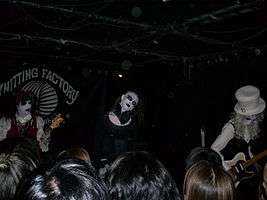 The Candy Spooky Theater with white face paint in New York City 2007.
The Candy Spooky Theater with white face paint in New York City 2007.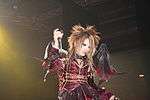 Dio – Distraught Overlord vocalist Mikaru wearing a costume in Paris 2007.
Dio – Distraught Overlord vocalist Mikaru wearing a costume in Paris 2007. Penicillin vocalist Hakuei in Paris 2008.
Penicillin vocalist Hakuei in Paris 2008. Vistlip wearing matching outfits in Paris 2009.
Vistlip wearing matching outfits in Paris 2009. Vivid guitarist Ryōga in Paris 2010.
Vivid guitarist Ryōga in Paris 2010.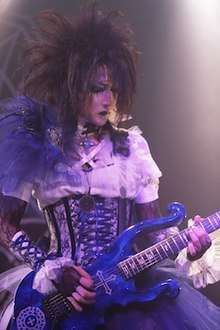 Moi dix Mois guitarist Mana performing in 2011.
Moi dix Mois guitarist Mana performing in 2011.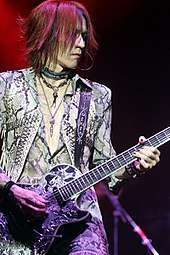
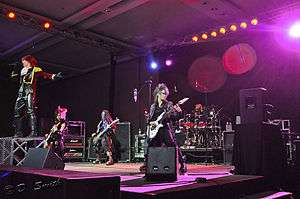 All-female band Exist Trace in Pittsburgh 2012.
All-female band Exist Trace in Pittsburgh 2012.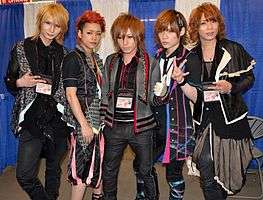 DaizyStripper in Alberta 2012.
DaizyStripper in Alberta 2012.
See also
| Wikimedia Commons has media related to Visual kei. |
Notes
- "Visual Kei 101 – Segment 1: the GazettE". MTV. 11 November 2013. Archived from the original on 21 April 2016. Retrieved 20 August 2017.
Visual-kei is a uniquely Japanese music scene, but it doesn't have a specific sound – it's more of a movement.
- "International Music Feed feature "J Rock"". International Music Feed. Archived from the original on 12 October 2007. Retrieved 31 July 2007.
- Kristen Sollee (25 June 2006). "Japanese Rock on NPR". The Big Takeover. Retrieved 7 June 2013.
It's a style of dress, there's a lot of costuming and make up and it's uniquely Japanese because it goes back to ancient Japan. Men would often wear women's clothing...
- Strauss, Neil (18 June 1998). "The Pop Life: End of a Life, End of an Era". The New York Times. Retrieved 20 August 2017.
For visual kei bands, outrageous, usually androgynous looks – gobs of makeup, hair dyed and sprayed in ways that made Mohawks look conservative and a small fortune spent on leather and jewellery – were as important as music (or, in many cases after X, more important than music).; To a certain extent, Hide's death means the end of an era, said Steve McClure, Tokyo bureau chief for Billboard, the music-industry magazine. X were the first generation of visual kei bands, but the novelty has worn off. For the next generation of bands, it's like: That's it. The torch has been passed to us.
- Reesman, Bryan (30 November 2006). "Kabuki Rock". Grammy.com. Archived from the original on 28 September 2007. Retrieved 7 August 2007.
Josephine Yun, author of the book Jrock, Ink., explains that visual kei originated in the late 1970s and early 1980s as Japan's rock scene began cultivating its own identity. 'It was rock 'n roll, punk rock, glam and metal with a twist – a twist just as angry and rebellious as what came before it – but a poetic one, artistic, with painstaking attention to detail,' Yun explains. She points out that "visual kei" literally translates as "visual style" and spans a wide range of musical genres.; Musically, it can be anything: American rock, British punk, glam, metal, Euro-pop, techno, new wave, electronica," explains Yun. "Visually, the influences are diverse as well: traditional Japanese dress, S&M outfits, costumes made of vinyl, leather, lace, plastic...you name it."
- Suzuki, Chako (January 2007). "Pretty Babies: Japan's Undying Gothic Lolita Phenomenon". fashionlines.com. Retrieved 7 June 2013.
Visual Kei is exactly as it sounds: Rock music that incorporates visual effects and elaborate costumes to heighten the experience of the music and the show. Visual Kei started in the 80s and became so popular by the 90s that the nearly all-female fan base started dressing up as their favorite band members (known as 'cosplay') who were often males that wore make-up, crazy hair and dressed androgynously or as females (usually, the more feminine the rocker, the more fans rush to emulate them).
- Pfeifle 2013, pp. 74, 78.
- Heinrich, Sally (2006). Key into Japan. Curriculum Corporation. p. 80. ISBN 1-86366-772-5.
- Josephine Yun (2005). Jrock, Ink.: A concise report on 40 of the biggest rock acts in Japan. Stone Bridge Press. ISBN 1-880656-95-7.
- Subha Arulvarathan (15 April 2006). "For those about to J-Rock". The Carillon. Archived from the original on 11 October 2007. Retrieved 7 June 2013.
Visual kei is a branch of Japanese rock. It has its roots as an underground movement in the late '80s and early '90s and can be considered pastiche, as it aims to experiment with various established genres such as rock, punk, metal, goth and glam in an attempt to create a wholly new sound.
- Chi Minnie (15 April 2006). "X [Japan]: Reliving the Height of Japan's Superlative Visual Rock Band". asiaarts.ucla.edu. Archived from the original on 11 October 2007. Retrieved 7 June 2013.
...a fleeting genre known to fans as 'Visual Kei'. Nonetheless, this fusion of metal, punk and gothic aesthetics ignited at least two generations of followers with its shocking visual appeal...; 'Visual Kei' as a genre has more or less expired since the late '90s. The music that derived from the scene has transformed and visual bands have generally subdued their appearance.
- Dave Gibson (2 November 1998). "Rising Sun". Fort Worth Weekly. Retrieved 20 August 2017.
Born of a combination of hard rock and metal, visual rock leans toward a more theatrical presentation emphasizing imagery as much as music. One only needs to watch an X-Japan video to recognize its decadent glam influences, as drummer Yoshiki is often decked out in lace stockings and torn black leather vests. However, the band's androgynous looks can be attributed as much to kayou kyoku (traditional Japanese pop) as to the eccentric costumes of '70s David Bowie and '80s hair bands. It is precisely this hodgepodge of international styles that makes visual rock such a noteworthy new genre.
- Utz & Lau 2013, pp. 250–251.
- Allyson B. Crawford (14 August 2009). "D'espairsRay Explains Visual Kei Movement, Expressing Emotions". Noisecreep. Retrieved 20 August 2017.
Musically speaking, visual kei can do anything.
- Robson, Daniel (27 April 2007). "Shock-rock act Dir En Grey snub cartoons for cred". The Japan Times. Retrieved 7 June 2013.
...visual-kei, where peacockish fashion far overshadows any definitive sound.; To be honest, when we first started and we were wearing a lot of makeup on stage and stuff, there were a lot of bands doing that at the time in Japan and people thought it was cool. But not anymore, ha ha. The music was so unique, too – bands like X Japan. At that time, there weren't any two bands that sounded alike; these days everyone sounds exactly the same
- "UnsraW interview". JaME-World.com. 27 April 2007. Retrieved 7 June 2013.
[…]Visual kei is not really categorized based on the type of music...
- Daniel Robson (20 November 2011). "Interview with YOSHIKI in Brazil". JaME-World.com. Retrieved 20 August 2017.
But visual kei is more like a spirit, it's not a music style or, you know… I think it is a freedom about describing myself, a freedom to express myself, that's what I believe visual kei is.
- "Interview with Angelo". JRock Revolution. 24 November 2008. Archived from the original on 13 November 2013. Retrieved 7 June 2013.
Well I still don't think "visual kei" is a name for a genre; I see it as a bigger picture, as a part of rock. The visual aspect is something for a band to set themselves apart from others, at least that's what it was ten years ago. Now it's more like people are dressing up a certain way because they want to be "visual kei" or look "visual kei." They are doing it to look like others instead of doing it to look different. This is obviously very different from when we started out more than ten years ago. That's how I see it.
- "Interview with MUCC at RTOC". JaME World. 25 July 2008. Retrieved 14 November 2015.
[…]Visual kei is not a style of music, but the whole physical image of the band.
- "the Underneath Debuts: Interview Part 1". JRock Revolution. 29 February 2008. Retrieved 20 August 2017.
Well, visual kei isn't a genre of music; it's used to categorize the bands that show their unique characteristics with their costumes and makeup, though sometimes the music doesn't necessarily fit the image. Either way, it's used to describe such bands that show their individualism through their appearance.
- "Visual Kei 101 – Segment 2: the GazettE". MTV. 12 November 2013. Retrieved 20 August 2017.
Visual kei isn't a genre of music.
- Utz & Lau 2013, p. 250.
- Kouji Dejima. "Bounce Di(s)ctionary Number 13 – Visual Kei". Bounce (in Japanese). Archived from the original on 1 March 2008. Retrieved 12 September 2007.
- Inoue, Takako (2003). Visual kei no jidai. Tokyo: Seikyūsha. ISBN 978-4-7872-3216-8.
- "Interviewing the man who coined the term "Visual kei", Seiichi Hoshiko". JRock News. 24 January 2018. Retrieved 24 January 2018.
- "Interview: How Seiichi Hoshiko was impacted by hide of X Japan". JRock News. 31 January 2018. Retrieved 18 March 2018.
- Utz & Lau 2013, p. 250: "In the late 1980s and during the 1990s, Japanese bands like Dead End, Buck-Tick, or Luna Sea performed... The most successful and influential of these bands certainly was X Japan."
- Tiffany Godoy; Ivan Vartanian (2007). Sokstyle Deficit Disorder: Harajuku Street Fashion - Tokyo. Chronicle Books. ISBN 9780811857963.
...while Kiss is a heavy metal band, visual kei bands like X Japan, Color, Dead End and D'erlanger are by and large a cross between metal, punk, goth, cyber and rock. The sounds are hard and the looks are dark and severe.
- Taiyo Sawada (21 July 2015). 第110回:「ロックと日本の60年」第11章 バブルの喧噪に射し込んだニルヴァーナ. DrillSpin (in Japanese). Sockets. Archived from the original on 23 July 2015. Retrieved 29 September 2016.
それは、X JAPANやDEAD ENDのようなメタルの影響の強いものや、BUCK-TICKのような80sのゴス系ニュー・ウェイヴ(第10章参照)のタイプ、ハードコア・パンクからメタルに進化したGastunkに影響されたものまで雑多なものでしたが、それらはやがて外見上の傾向で括られ“ヴィジュアル系”と呼ばれるようになります。
- Pfeifle 2013, p. 78.
- Pfeifle, Megan (4 June 2011). "Introducing Globalizing Visual Kei: A Web Series". JaME World. Japanese Music Entertainment. Retrieved 20 August 2017.
- "Shinjidai ni Totsunyu! Neo Visual Kei Band Taidō no Kizashi". Oricon (in Japanese). 7 June 2006. Retrieved 20 August 2017.
- 短期集中連載:増田勇一のDEAD END回想録(1)『DEAD LINE』. barks.jp (in Japanese). 4 August 2009. Retrieved 20 August 2017.
- 短期集中連載:増田勇一のDEAD END回想録(3)『SHAMBARA』. barks.jp (in Japanese). 11 August 2009. Retrieved 10 September 2011.
- "LUNA SEA: God Bless You". JRock Revolution. 27 August 2007. Archived from the original on 9 January 2016. Retrieved 1 March 2013.
- "Indies eXplosion: The Early History of X JAPAN". JRock Revolution. 29 October 2007. Archived from the original on 1 July 2015. Retrieved 3 February 2013.
- "BIOGRAPHY バイオグラフィ hideモバイル-JETS-". hide-city.com (in Japanese). Retrieved 13 January 2019.
- "X、初期のリマスター再発商品2作が好調!" (in Japanese). Oricon. 14 February 2007. Retrieved 20 April 2016.
- "The Jrock Legend: X Japan". JRock Revolution. 26 August 2007. Retrieved 20 August 2017.
- "Visual Kei and Extasy Records". JRock Revolution. 25 August 2007. Retrieved 20 August 2017.
- Road 2018, p. 362.
- 【V系】ヴィジュアル系はもう「終わり」?「2012年のV系を振り返る」第3回(ゲスト:NoGoD 団長) - (in Japanese). CyberAgent, Inc.. 31 December 2012. Retrieved 9 September 2018.
- 野中すふれ (14 March 2016). 「今夜はカラオケしマクリマクリスティ」90年代を代表するヴィジュアル系四天王 (in Japanese). Excite Japan Co.,Ltd.. Retrieved 9 September 2018.
- PIERROT11年ぶり本格復活! DIR EN GREYと異色プロジェクト始動 (in Japanese). Oricon. 1 January 2017. Retrieved 9 September 2018.
- DIR EN GREYのプロフィール (in Japanese). Oricon. Retrieved 9 September 2018.
- 清水素子 (28 July 2017). PIERROT×DIR EN GREY 『ANDROGYNOS』がもたらした“丘戦争”と歴史的融和 (in Japanese). E Plus Inc.. Retrieved 9 September 2018.
- Shun (27 January 2015). SHUN.'S FAVORITE THINGS Vol.30 90年代名古屋系. Visulog. Retrieved 7 September 2018.
- Road 2018, p. 366.
- extrax Laputa 1999, pp. 104–105
- ラピュータ. cdjournal.com (in Japanese). CDジャーナル. Retrieved 7 September 2018.
- Bunny Bissoux (11 June 2015). "The story of visual kei". TimeOut. Retrieved 20 August 2017.
- Henry Johnson, Akitsugu Kawamoto (2016). "Visual Kei: Glamour in Japanese Pop Music". In Ian Chapman, Henry Johnson (ed.). Global Glam and Popular Music: Style and Spectacle from the 1970s to the 2000s. Routledge. p. 202. ISBN 9781317588191.
- Rob Schwartz (23 March 2012). "L'Arc-en-Ciel, Japanese Visual Rock Band, To Play Madison Square Garden This Weekend". Billboard.
- "Wrasse Records Biography". Wrasse Records. Retrieved 2 May 2014.
- "Japanese rock singer Miyavi makes debut in 'Unbroken'". Los Angeles Times. 31 October 2014. Retrieved 23 February 2017.
- Lara Garnermann (18 April 2010). "Oshare Kei". JaME World. Japanese Music Entertainment. Retrieved 11 January 2019.
- Pfeifle 2013, pp. 79, 86.
- Pfeifle 2013, pp. 78–79.
- Pfeifle 2013, p. 81.
- JKlein (11 August 2009). "V-Rock Festival 2009". JRockRevolution. Retrieved 20 August 2017.
- Polina & Kay (22 December 2011). "V-Rock Festival 2011 - White and Rainbow Stages". JaME World. Japanese Music Entertainment. Retrieved 29 September 2016.
- Remy Zane (29 May 2012). "V-Rock Festival 2011 - Rose and Moon Stages". JaME World. Japanese Music Entertainment. Retrieved 20 August 2017.
- "伝説のロックバンド・DEAD END、20年ぶりに復活" (in Japanese). Oricon. 3 July 2009. Retrieved 12 January 2019.
- ラクリマ再結成! 来年ツアーへ 世界初のV-ROCKフェス初日に1万5000人 (in Japanese). Oricon. Retrieved 19 July 2015.
- 解散から1年を経て黒夢本格的復活&SADSも7年ぶり再始動 (in Japanese). ナタリー. Retrieved 19 July 2015.
- 【エンタがビタミン♪】LUNA SEAが終幕と復活の真相語る。「ここで終わらせるのは罪だと思った」。 (in Japanese). Techinsight. Retrieved 19 July 2015.
- Daisuke Kikuchi (31 July 2015). "Luna Sea Celebrate 25th Anniversary With Star-studded Lunatic Fest". MTV. Retrieved 20 August 2017.
- "Luna Seahosts Lunatic Fest. 12 artists perform on 3 stages (Moon, Shine, Fate)". barks.jp. 14 April 2015. Archived from the original on 14 April 2015. Retrieved 20 August 2017.
- Tomo (21 July 2015). "Lunatic Fest. at Makuhari Messe: Part #1". JaME World. Japanese Music Entertainment. Retrieved 20 August 2017.
- Tomo (25 July 2015). "Lunatic Fest. at Makuhari Messe: Part #2". JaME World. Japanese Music Entertainment. Retrieved 20 August 2017.
- Tomo (2 August 2015). "Lunatic Fest. at Makuhari Messe: Part #3". JaME World. Japanese Music Entertainment. Retrieved 20 August 2017.
- "Luna Sea "Lunatic Fest." Lunacy was announced as the opening act for both days". barks.jp. 1 June 2015. Archived from the original on 9 August 2016. Retrieved 20 August 2017.
- "The Legend of Visual-Kei begins here once again "Visual Japan Summit 2016 Powered by Rakuten" is officially confirmed!". Sync Music Japan. 16 August 2016. Retrieved 20 August 2017.
- ""Visual Japan Summit 2016 Powered by Rakuten" makes 4th release of artist lineup with 29 more groups". Japan Finder. 9 September 2016. Retrieved 20 August 2017.
- "「LUNATIC FEST.」にGLAY、back number、大黒摩季登場". Natalie (in Japanese). 16 April 2018. Retrieved 16 April 2018.
- "TOP 15 VISUAL KEI AND JAPANESE ACTS OF 2017". jrocknews.com. 4 December 2017. Retrieved 17 October 2019.
- "Ranking (2018)". CDJapan. Retrieved 17 October 2019.
- "Ranking (2019)". CDJapan. Retrieved 17 October 2019.
- "Ranking (2016)". CDJapan. Retrieved 17 October 2019.
- "Sugizo on Luna Sea". Jame World. 10 February 2010. Retrieved 20 August 2017.
- "Interview: The Killing Red Addiction". JRock Revolution. 12 July 2009. Retrieved 20 August 2017.
- Mike Mascia. "Dir en grey feature interview". Blistering. archive.is. Archived from the original on 28 July 2012. Retrieved 20 August 2017.
When we were growing up around [the] late '80s and early '90s, visual kei was influenced by glam music.
CS1 maint: BOT: original-url status unknown (link) - Pfeifle 2013, pp. 78, 83.
- "dokidoki: raptor startet neues Magazin" (in German). otaji.de. 10 August 2015. Retrieved 18 October 2019.
- Utz & Lau 2013, p. 251.
- Pfeifle, Megan (30 July 2011). "Globalizing Visual Kei: Investigating the Visual Style". JaME World. Japanese Music Entertainment. Retrieved 20 August 2017.
- Pfeifle 2013, p. 82.
- Utz & Lau 2013, pp. 17, 262–288.
- Utz & Lau 2013, p. 258.
- Utz & Lau 2013, pp. 258–262.
References
English
- Pfeifle, Megan (2013). "Exposing the Underground: The Japanese Subculture of Visual Kei". The George Mason Review. 21. The George Mason Review. pp. 74–87.CS1 maint: ref=harv (link)
- Utz, Christian; Lau, Frederick (2013). Vocal Music and Contemporary Identities: Unlimited Voices in East Asia and the West. Routledge. ISBN 978-1-136-15521-5.CS1 maint: ref=harv (link)
Japanese
- 加納一美(KANO Kazumi) (27 October 1999). Laputa―from the cradle to the grave 1999 (Fool's Mate extrax). FOOL'S MATE extrax. FOOL'S MATE. ISBN 4-938716-18-6.
- 市川哲史(ICHIKAWA Tetsushi); 藤谷千明(FUJITANI Chiaki) (26 August 2018). すべての道はV系へ通ず。 [Every Road Leads to the V Kei.]. Shinko Music. ISBN 978-4-401-64639-5.
External links

.jpg)